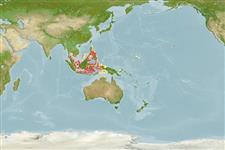>
Blenniiformes (Blennies) >
Blenniidae (Combtooth blennies) > Salariinae
Etymology: Ecsenius: Greek, exenios, -os, -on = uncontrolled, immoderate; tricolor: Name from the Latin 'tri-' meaning 3, and 'color', referring to the three stripes on the head; noun in apposition.
Environment: milieu / climate zone / depth range / distribution range
पारिस्थितिकी
समुद्री ड़िमरसल; गहराई सीमा 1 - 10 m (Ref. 48636). Tropical
Western Central Pacific: Philippines and Borneo.
आकार / वज़न / Age
Maturity: Lm ? range ? - ? cm
Max length : 6.0 cm TL पुल्लिंग / अलिंग; (Ref. 48636)
Short description
पहचान कुंजी | आकृति विज्ञान | मौरफोमैटरिक्स
Has a distinctive blue-white line below the eye that usually continues over the axil to above the anus on the body, bordered by a bright orange one below over the gill section. Head deep blue, continuing and gradually changing on the body to bright orange on the tail (Ref. 48636).
Adults inhabit seaward and sheltered reefs (Ref. 90102). They occur in coral rich habitats at about 10 m depth, usually among Acropora branches (Ref. 48636). Oviparous. Eggs are demersal and adhesive (Ref. 205), and are attached to the substrate via a filamentous, adhesive pad or pedestal (Ref. 94114). Larvae are planktonic, often found in shallow, coastal waters (Ref. 94114).
Life cycle and mating behavior
परिपक्व अवधि | पुनरुत्पत्ति | मछलीऔ का अंडे देना | अंडे | Fecundity | लार्वा
Oviparous, distinct pairing (Ref. 205).
Springer, V.G. and G.R. Allen, 2001. Ecsenius ops, from Indonesia, and E. tricolor, from western Philippines and northwestern Kalimantan, new species of blenniid fishes in the stigmatura species group. aqua, J. Ichthyol. Aquat. Biol. 4(4):151-160. (Ref. 55736)
IUCN Red List Status (Ref. 130435: Version 2024-2)
Threat to humans
Harmless
Human uses
साधन
Special reports
Download XML
इंटरनेट स्रोत
Estimates based on models
Preferred temperature (Ref.
123201): 28.5 - 29.3, mean 28.8 °C (based on 721 cells).
Phylogenetic diversity index (Ref.
82804): PD
50 = 0.5000 [Uniqueness, from 0.5 = low to 2.0 = high].
Bayesian length-weight: a=0.00776 (0.00356 - 0.01695), b=3.00 (2.81 - 3.19), in cm total length, based on LWR estimates for this (Sub)family-body shape (Ref.
93245).
Trophic level (Ref.
69278): 2.0 ±0.00 se; based on food items.
लौटाव (Ref.
120179): ऊंचा, न्यूनतम जनसंख्या दुगनी समय अवलागत 15 महीने। (Preliminary K or Fecundity.).
Fishing Vulnerability (Ref.
59153): Low vulnerability (10 of 100).
